Leptospermum is the most ornamental genus in the Myrtle family. Its foliage is fine and sculptural, and the five-podded seed capsules that develop after each fascinating flower are simply gorgeous. Everything about this plant cries out to be obsessed over in fine detail.
So let’s obsess. Let’s get to grips with these desirable garden plants, and get to know some of the cultivars and native species that make it one of Australia’s best-loved plants. And most importantly, take our time, because once in a while, it’s worth marvelling at the intricate design of each flower, and the silvery shine of its bark.
More...
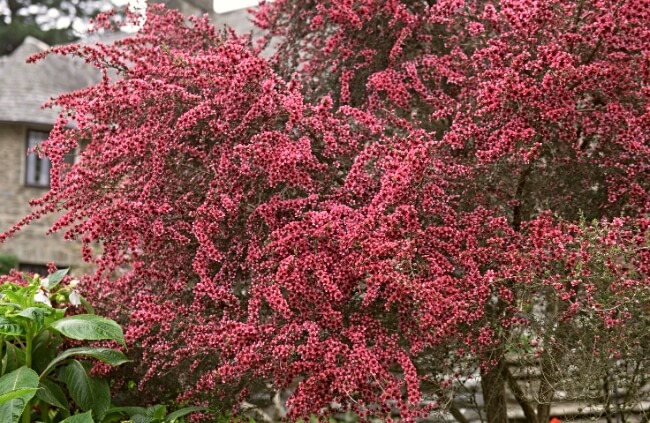
Family: | Myrtaceae |
|---|---|
Genus: | Leptospermum |
Species: | Various |
Origin: | Australia |
Common Name: | Tea tree |
Location: | Outdoor |
Type: | Small trees or shrubs |
Growth: | Varies by species |
Sun requirements: | Varies by species |
Foliage Colour: | Green |
Flower Colour: | Pink or white |
Flowering: | Late spring to summer |
Edible Parts: | Leaves are used to make herbal tea |
Maintenance level: | Low |
Poisonous for pets: | Essential oil is toxic to cats and dogs |
What is Leptospermum?
Leptospermum is a member of the tea tree family (family Myrtaceae), nearly all of which are native to Australia and New Zealand (but one or two are native to South east Asia).
They are recognisable thanks to woody stems and firm, usually pointed leaves. The stems are nearly always silvery-grey, while the green foliage has a tint of silver, and some Leptospermum species are just touched with reddish leaf borders.
The flowers of Leptospermum are distinctively shaped, with five evenly-sided petals, always with gaps between each, and a ring of stamens around a crisply separate ovary, made of five sections, which later become the fruit.
Once pollinated, the fruit of Leptospermum is a fleshy seed capsule, with five segments, looking similar to the base of an acorn, with the dried style poking out of the centre.
Tea Trees' Natural Habitat
The genus Leptospermum is made up of around 100 species. Most are native to south Australia, and most of them are to New South Wales. But that is where the similarities end.
Amongst the disparate species group of Leptospermum are some that love shaded rainforests, and others that grow best on sandy beaches.
What they do all share, is they are rarely fussy about their garden position and will grow in reasonably bright conditions, if the soil is quite poor.
Popular Leptospermum Varieties to Grow in Australia
There are over a hundred species of Leptospermum, each with variations on common names, and the occasional hybrid thrown in to confuse matters, but there are only a handful that really stand out as perfect contenders for space in our Australian garden.
Below is an introduction to some of our favourite Leptospermums, with links to articles on how to grow and care for them. For more inspiration, and to explore the subtle differences within this varied genus, click through to find out more.
1. Leptospermum ‘Copper Glow’ The bronze tint to every silvery leaf along their russet-coloured stems of Leptospermum polygalifolium gives it its common name ‘Copper Glow’. It is an easy-going shrub, reaching a maximum height of roughly 3m, ideal for small gardens. | 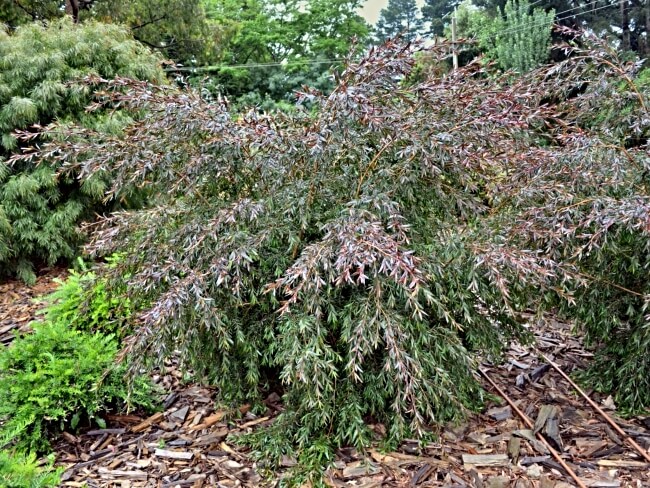 Source: Gardening With Angus |
2. Leptospermum ‘Pink Cascade’ Leptospermum scoparium ‘Pink Cascade’ is a stunning cultivar, with weeping foliage that can cascade, quite literally, over walls, and from tall plant pots or containers. If grown in beds or borders, it makes a beautiful ground cover plant. | 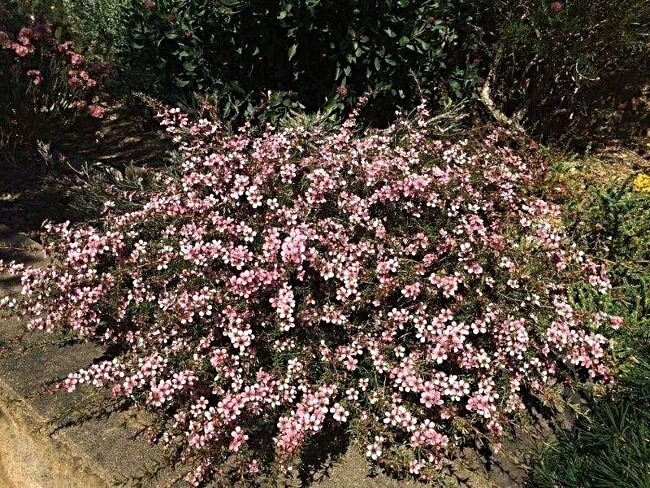 Source: Granton Plants |
3. Leptospermum lanigerum The crisp white flowers of the woolly tea tree, Leptospermum lanigermum, set off this spectacularly unique plant in style. It works in pretty much any planting arrangement, and its white flowers can be cut and used in vases too. The shrub itself reaches around 3m tall, and will generally develop into an even dome. | 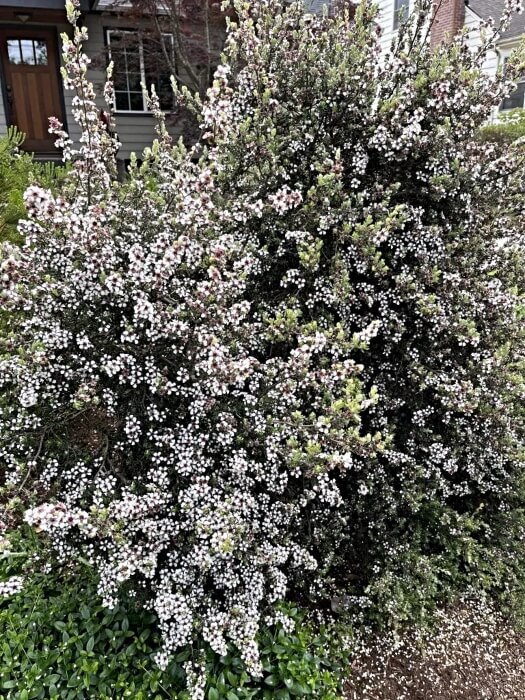 Source: Xera Plants |
4. Leptospermum turbinatum Leptospermum turbinatum, commonly called the shiny tea tree, is one of the more diminutive species of Leptospermum, reaching just 1.5m tall at maturity. Its waxy foliage gives it its common name. | 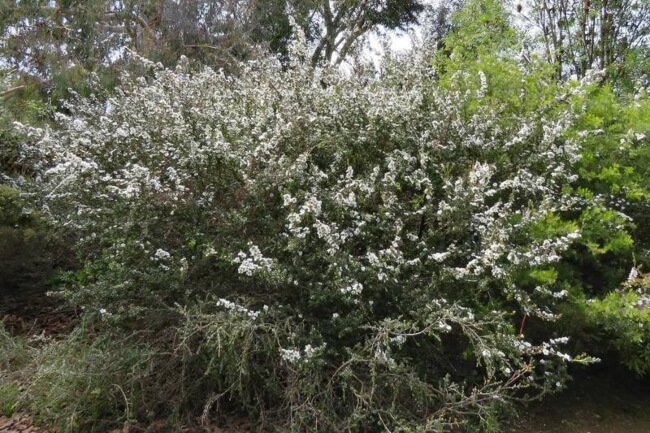 Source: Dave's Garden |
5. Leptospermum spectabile Leptospermum spectabile is an unusual; species, with rich, russet-red flowers and pale white sepals. The flowers are more subtle, but in detail and up close are far more detailed than any other cultivar or species, and perfectly set off the narrow, spear-shaped leaves that grow abundantly along its branches. |  |
6. Leptospermum petersonii The most common Leptospermum for garden use is Leptospermum petersonii. Lemon scented tea tree makes a stunning hedging plant and is established in no time. If left completely to its own devices it can reach 4.5m tall and makes a great privacy screen, but it also responds well to pruning. | 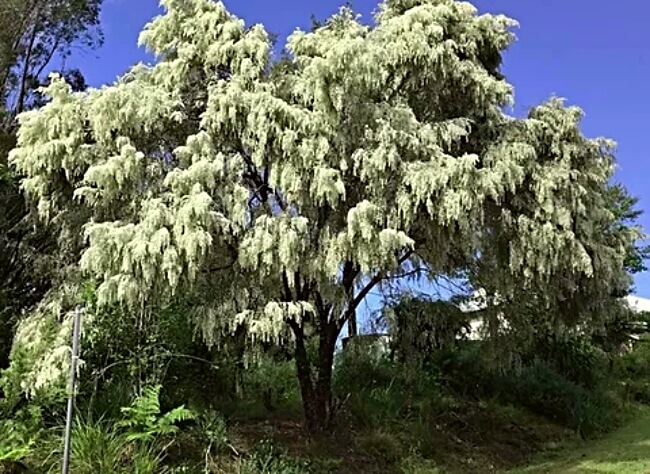 Source: Living Green and Feeling Seedy |
1. Leptospermum ‘Copper Glow’

Source: Gardening With Angus
The bronze tint to every silvery leaf along their russet-coloured stems of Leptospermum polygalifolium gives it its common name ‘Copper Glow’. It is an easy-going shrub, reaching a maximum height of roughly 3m, ideal for small gardens.


Get Your Free Guide:
Master Growing Australian Natives eBook
A Must Have Complete Guide for Every Australian Garden
Get Your Free Guide:
Master Growing Australian Natives eBook
A Must Have Complete Guide for Every Australian Garden
Leptospermum polygalifolium ‘Copper Glow' growing guide
2. Leptospermum ‘Pink Cascade’

Source: Granton Plants
Leptospermum scoparium ‘Pink Cascade’ is a stunning cultivar, with weeping foliage that can cascade, quite literally, over walls, and from tall plant pots or containers. If grown in beds or borders, it makes a beautiful ground cover plant.
Leptospermum scoparium ‘Pink Cascade' growing guide
3. Leptospermum lanigerum

Source: Xera Plants
The crisp white flowers of the woolly tea tree, Leptospermum lanigermum, set off this spectacularly unique plant in style. It works in pretty much any planting arrangement, and its white flowers can be cut and used in vases too.
The shrub itself reaches around 3m tall, and will generally develop into an even dome.
Leptospermum lanigerum growing guide
4. Leptospermum turbinatum

Source: Dave's Garden
Leptospermum turbinatum, commonly called the shiny tea tree, is one of the more diminutive species of Leptospermum, reaching just 1.5m tall at maturity. Its waxy foliage gives it its common name.
5. Leptospermum spectabile

Leptospermum spectabile is an unusual; species, with rich, russet-red flowers and pale white sepals. The flowers are more subtle, but in detail and up close are far more detailed than any other cultivar or species, and perfectly set off the narrow, spear-shaped leaves that grow abundantly along its branches.
Leptospermum spectabile growing guide
6. Leptospermum petersonii

Source: Living Green and Feeling Seedy
The most common Leptospermum for garden use is Leptospermum petersonii. Lemon scented tea tree makes a stunning hedging plant and is established in no time. If left completely to its own devices it can reach 4.5m tall and makes a great privacy screen, but it also responds well to pruning.
How to Grow Leptospermum
Leptospermum is pretty simple to grow. Provided it isn’t in full shade, and its roots are never waterlogged it will generally survive quite happily without any real care.
Ideal Conditions for Planting Leptospermum
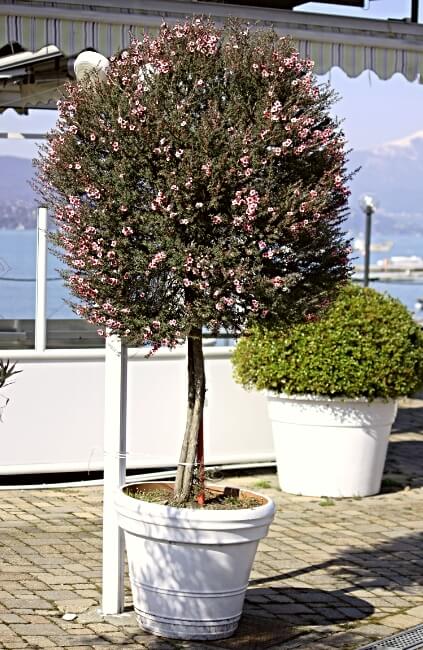
Soil & Drainage
The only thing that Leptospermum is ever fussy over is soil. It is a fairly typical Australian native in that way, throwing tantrums if you try and offer it nutrition.
They like moisture-retentive, nutrient-poor soil, so if you have to improve your soil structure before planting, avoid using rich topsoil or manures. Add well-rotted composts instead, which add less nutrients, but help to support balanced moisture levels.
Avoid nutrient-rich, healthy soil if you can, or dig sand or grit through wet clay soils before planting to reduce nutrient availability.
Light & Temperature
The best spot for any Leptospermum is in full sun, but part shade will usually be fine, provided it is reasonably warm and the soil drains well.
Not all Leptospermums are frost-hardy, but the vast majority will have no trouble in Australian winters, so can be planted outdoors without any frost protection.
Shelter
As you can probably guess from looking at Leptospermum, they are well adapted to quite harsh conditions. If you have a coastal garden, they are an excellent choice as wind-breaking plants and can survive in salty air too.
Planting Leptospermum
No special preparation is needed before planting Leptospermum in the garden unless the soil needs amending (see above). Dig a hole twice the size of the root ball, and gently tease out any roots that have wrapped around the pot.
Backfill the planting hole with the same substrate you removed, and firm it in with your heel. After planting, soak the root with a full can of water once a week during its first summer. Do not water in its first winter, and once it establishes, it should never need watering.
How to Propagate Leptospermum
Tea tree can be propagated from both seeds and cutting. Propagation from cuttings is faster, but seeds require very little care, provided you are willing to wait longer for a good-sized plant.
Below, we have put together step-by-step guides for both forms of Leptospermum propagation.

Propagating Leptospermum from Seeds
Tea tree seeds naturally germinate when they hit warm soil. In nature (and in your garden) last year’s seed pods are often still clinging onto the plant and will remain viable for around 12 months.
Sowing seeds that are in recently dried pods in autumn is usually more reliable.
You will need:
- A seed tray or propagator
- Heated propagator (optional)
- Seed and cutting compost
Method:
- Start by collecting Leptospermum seeds, ideally in mid-autumn
- Fill a seed tray with seed compost
- Sow Leptospermum seeds thinly in rows so they are easier to handle later
- If temperatures are below 18°C, use a heated propagator to kickstart germination
- Keep the soil moist
- Germination usually takes around three weeks but can take up to six weeks
- If using a heated propagator, turn off the heat when seedlings break through
- When seedlings are large enough to handle, prick them out into individual pots and grow on over winter
Leptospermum Propagation from Cuttings
Leptospermum cuttings are much faster and can root after just 14 days in water. Take hardwood cuttings in spring or summer from the previous year’s growth, or semi-hard cuttings in autumn.
As long as you remove flowering shoots from your cuttings, they should take in a simple mix of perlite and peat-free compost.
Method:
- Fill plastic 10-15 cm tall pots with a 50:50 mix of compost and perlite (or clean dry sand).
- Cut a 30 cm section of hard or semi-hardwood material from your Leptospermum, taking note of the tip and base
- Cut into 10 cm sections, with the top end cut at an angle, and the base cut straight so you know which is which
- Insert the base of each cutting into the compost
- Cover with a plastic bag, and leave for a month, misting if the soil dries out
- Cuttings will be ready to plant out after 12-24 months
Alternatively, root 10-15 cm sections in water, and transplant them when they have enough roots. This method can cause fungal problems when transplanting, but rooting is more reliable.
How to Care for Leptospermum
Caring for mature or established Leptospermum is a case of sitting back and watching. The more you intervene, the more likely they are to develop problems.
That means no mulching, no feeding, and no watering unless there is a really severe prolonged drought. Remember Leptospermum do not like nutrients, but they do like regular and consistent moisture where possible.
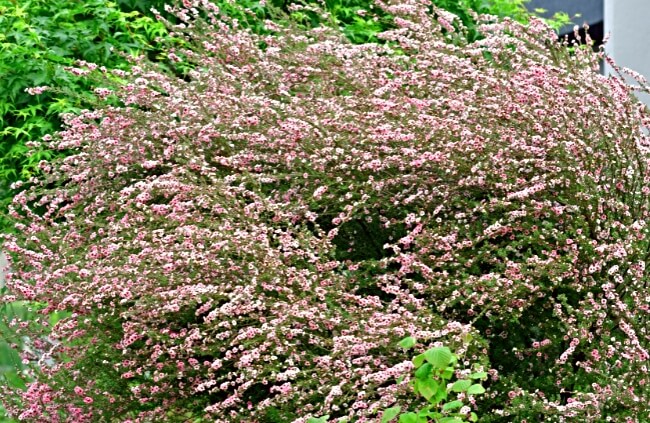
Pruning Leptospermum
Leptospermum will grow naturally into a wonderful shape, regardless of the species you choose. Some are small, and others grow as trailing and even weeping shrubs, but nearly all will grow evenly in all directions.
If you do need to prune Leptospermum, due to damage, or oddly shaped growth, aim to prune in spring so your plant has a chance to recover.
If you are pruning out dead or diseased growth, prune it immediately with clean tools to limit any spread of infection, regardless of the time of year.
Repotting Leptospermum
You can grow smaller cultivars of Leptospermum in pots and containers, which makes for a beautiful ornamental display in summer when they are in full bloom.
Their roots are reasonably happy in restricted conditions, and most Leptospermum species won’t mind potting compost running out of nutrients either, but keep an eye on the size of your plant, and if it’s getting too big, or the roots are becoming pot-bound, lift it and plant it into a larger pot.
You can jump up a few sizes, as any excess moisture sitting in compost around the roots will be welcomed by these moisture-loving ornamental shrubs.
Leptospermum Pests and Diseases
Thankfully, Leptospermum are generally pest and disease-free, but there are still a few common pests that can cause problems, and some issues that can arise from planting them in the wrong position.
The three pests that are regularly reported as problems on Leptospermum are leaf borers, webbing caterpillars and the ever-present scale insect. You can spot each one easily.
Borers
Black twig borers are common on tea trees (all Myrtles, not just Leptospermum). They bore into twigs, young growth, and any damaged parts of the main trunk. The easiest way to spot them is by checking for sawdust at the entrance to their holes.
There are no effective deterrents for borers on tea trees (ironically tea tree essential oil is advised as a treatment for borers on other plants!), so organic pesticides are the only option. Directly treating or even spraying pyrethrin sprays into the borer holes can kill them.
Tea tree web moth
The tea tree web moth, also called the webbing caterpillar, protects itself by creating a silky web around clusters of leaves, usually on the lower branches of tea tree plants. In large enough numbers, they can cover entire plants with a fine silky web, which locks in moisture and causes fungal infections that can kill whole trees.
If you notice a small infestation of webbing caterpillars on a Leptospermum, remove them by hand and feed them to the birds.
Scale insects
Scale insects are problematic pests. They cover themselves in foul-tasting secretions so most predators will not go near them. If you notice loads of fungal spots on tea tree plants, remove the affected area and burn it.
If the problem repeats, treat infestations of scale on Leptospermum with a direct application of neem oil. This kills the current pests and deters future scale insects from settling.
There are not many common diseases with Leptospermum, but some root rot caused primarily by over-feeding on damp soil is occasionally reported.
Avoid very wet ground. Plant Leptospermum in reasonably well-drained conditions with enough organic matter to hold moisture.
Leptospermum Frequently Asked Questions
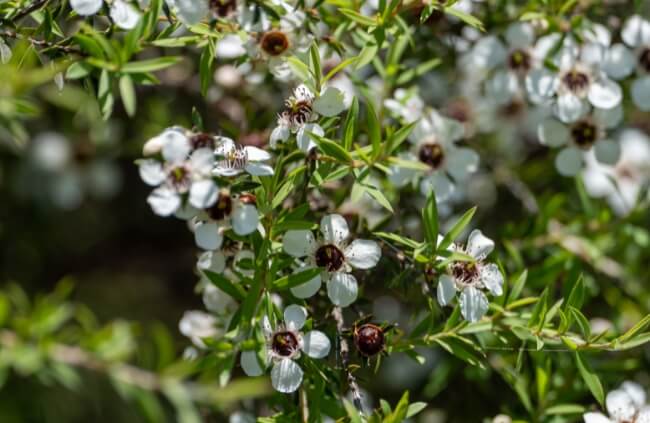
How tall does Leptospermum grow?
There are some dwarf cultivars and short species of Leptospermum, but most small tree varieties grow to around 4m tall.
How long do Leptospermum trees live?
Leptospermums tend to live for around 60 or more years. They are long-lived and fairly easy-going plants, so are a good way to add longevity to your garden planting.
When should my Leptospermum be cut back?
Cut back Leptospermum in early spring, before flower buds and new growth start to form. It will; encourage plenty of new growth in a more even shape, and your plants will typically flower later in summer as a result.
What is the best Leptospermum for hedging?
The best Leptospermum for hedging is Leptospermum petersonii (Lemon scented tea tree), which grows to around 4.5m if left to its own devices, and will establish sooner to fill out a boundary, providing a fuller-looking, easy-going, hedge in no time.
Is Leptospermum evergreen?
Most species of Leptospermum are evergreen shrubs or small trees. Holding foliage right through winter regardless of the temperatures or conditions.
Is Leptospermum the same as Manuka?
Leptospermum scoparium is commonly used medicinally and referred to as manuka. Along with Kunzea ericoides, alone native to New Zealand, they are both pollen sources for manuka honey.
Is Leptospermum toxic to animals?
Leptospermum essential oils are toxic to cats and dogs even in small quantities, and tea tree soil should not be consumed by mount by either animal. The plant is off-putting to dogs and cats, so neither will eat the foliage.
Enjoy the Beauty of Leptospermum in Your Garden
Leptospermum are fascinating Australian native plants, and ideal for fast-growing gardens without risking sudden growth spurts, as you would when planting other natives like Acacia.
If you want to grow your own Leptospermum at home, remember that it is all about limiting nutrients, and managing moisture. They do not like waterlogging, but they are never overly happy with drought either. Find a good spot, and you will have a beautiful established Leptospermum growing in your outdoors in no time.
Published on December 22, 2023 by Nathan Schwartz
Last Updated on October 18, 2024




